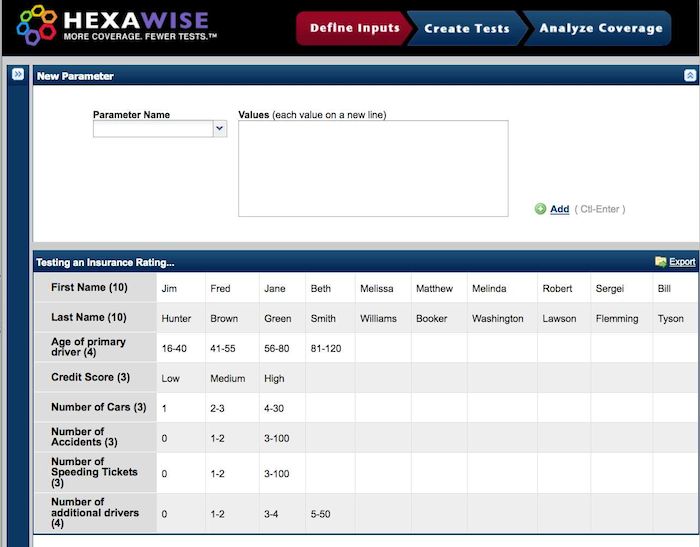How Not to Design Pairwise Software Tests

How Not to Design Pairwise Software Tests
I am passionate about pairwise software testing techniques. I have helped dozens of teams, for example, carefully measure the benefits that can be created when teams of testers adopt pairwise and related combinatorial testing approaches to identify the test cases they will execute (as compared to manual test case identification methods). What usually happens is that tester productivity doubles. (See Combinatorial Software Testing - pdf download).
I believe these approaches will be much more widely adopted in a few years than they are now for the simple reason that they consistently deliver dramatic benefits to both the speed of software test design and the efficiency and thoroughness of software test execution. As more teams try these methods for themselves, and measures the benefits they achieve with them, broader adoption seems highly likely to me.*
I see three main barriers to broader adoption by the testing community at large:
-
The first barrier is that testers will not make an attempt to apply this method to their testing projects so they will never find out how effective it is. The second is that ill-informed testers will try to apply the approach but do such a poor job at implementation that they do not generate benefits.
-
The second barrier is that even testers who use the approach effectively a few times, will not realize how much more effective it is making them. A dismissive thought process guilty of this might sound something like this: "Those 11 bugs I just found? Yeah. I found them because I'm a good tester; the fact that I happened to use pairwise tests just now? That's largely irrelevant. I'm sure I would have found them regardless.")
-
The third barrier is that testers unfamiliar with the basics of pairwise testing principles will design test cases without thinking about what they are doing, and achieve "garbage in / garbage out" results. The benefits that would have been so easily achieved in the testing project - like Lindsey Jacobellis' opportunity to win a gold medal for Snow Boarding - disappear in a groan-worthy moment of bone-headed stupidity.
This blog post addresses this third barrier. When testers sabotage their own test plans with a poor choice of inputs, they may well blame the test design strategy rather than themselves, which would be unfortunate. Here's one common problem I see (exaggerated a bit in this example to make my point).
Objective: create a set of tests that will check to see if the underwriting engine for a car insurance firm is calculating premium estimates correctly.
Our aspiring pairwise test designer enters stage left and identifies a set of parameters:
First Name, Last Name, Age of Primary Driver, Credit Score, Number of Cars, Number of Accidents, Number of Speeding Tickets, and Number of Additional Drivers
So far so good. We now have the initial ingredients for a thing of beauty; we have a set of parameters that could quickly result in a combinatorial explosion of possibilities and, ready to save the day, we have a test designer who has correctly identified this as an opportunity to achieve efficiency and thoroughness benefits through the application of pairwise testing methods. Our potential hero is a couple minutes away from creating a concise set of tests that will confirm not only confirm that each of the data points in the plan work as they should but that they work as they should in combination with each of the other data points in the test plan.
In other words, the plan will not only confirm that "Number of Accidents = 3" will impact premiums as it should on its own, but also that "Number of Accidents = 3" will work as it should when tested in combination with the other relevant inputs in the application, e.g.,: 3 accidents with every relevant input for "Age of Primary Driver," 3 accidents with every relevant input for "Credit Score," 3 accidents with every relevant input for "Number of Cars," 3 accidents with every relevant combination for "Number of Speeding Tickets," and 3 accidents with every relevant input for "Number of Drivers."
He's seen the Promised Land of improved efficiency and effectiveness and he's ready to enter. Unfortunately, with his next move, he demonstrates he's a doofus. Entry to Promised Land denied. Check out the values he chose to enter for each of his parameters.

Notice anything wrong here?
Just for fun, let's take a close up look at Lindey's disastrous Snow Boarding maneuver here.
... and let's break down our shame-faced test designer's bone-headed move here. Can you notice what is wrong in with his choices of values?
There are nine different parameters in the mix here. Of those, two ("First Name" and "Second Name"), are the least important to our current objective of looking for problems in the underwriting engine calculations. And yet...
He's added ten values to each of them. Oops! Whenever you are putting together a pairwise (or 2-way) test plan, the number of tests required will never be lower than the product of the number of parameter values from the two parameters that have the highest number of values. In plain English, that high-falutin' previous sentence means: when you have a plan with 7 parameters that have a maximum of 4 values each, "10 largely irrelevant values X 10 largely irrelevant values = you're a big fat idiot" because you'll create a test plan that has 100 test cases (as compared to a test plan that could have covered the System Under Test more effectively with fewer than a quarter of the tests you've just created).
For more information on pairwise and combinatorial testing, I would recommend the following sources:
-
Another good introductory article by Scott Selhorst - Test Smarter, Not Harder
-
A 7-minute demonstration and tool overview that explains how combinatorial testing methods deliver benefits during test design and test execution phases
If you are attempting to use pairwise and/or combinatorial testing methods and running into questions, I'd sincerely like to help. Please consider one or more of the following:
-
Post a comment here asking that I get in touch with you. Comments are moderated. I will not publish your comment and/or contact information.
-
Post a question to: getsatisfaction.com/hexawise
-
Post a question to: testing.stackexchange.com
Thank you,
*The manufacturing industry followed a similar pattern of adoption to similar methods that consistently delivered dramatic efficiency and effectiveness benefits. It took decades before multi-variate Design of Experiments methods were widely adopted by manufacturers even long after the benefits were proven to be dramatic and repeatable to anyone who would look at the clear, unambiguous, objectively-measurable evidence. Today, it is impossible to find a Fortune 500 manufacturing firm that does not regularly use multi-variate Design of Experiments in their manufacturing processes. One day it will be the same for Fortune 500 firms with respect to their adoption of multi-variate Design of Experiments methods of software testing.


